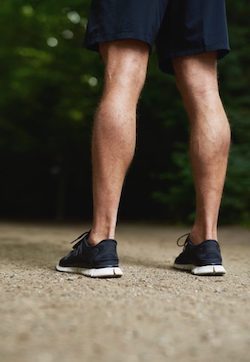Cosmetic surgery can be a really effective tool to help us tweak aspects of our appearance that we are unable to change through diet and exercise. If we look in the mirror and see an aging reflection we can have a facelift. If our breasts are to small we can have breast implants. If we cannot get rid of that stubborn belly fat, no matter how many times we hit the gym, we can have liposuction.
But what can we do if we are embarrassed about the shape of our legs?

When I say this many people may assume that I am talking about people who feel that their lower leg is too big? No I’m talking about the opposite problem – what about if we feel that our lower leg is ‘too small’….
Many men and women feel self conscious that their lower legs are out of proportion with the rest of their body. Men very commonly wish to add mass, bulk and definition to their calf area. Many body builders for example work hard to reach the upper limit of what they can achieve through exercise, but are still not happy with the definition of this hard to develop muscle area. Women often worry that their lower leg is widely disproportionate to the size of their thighs and many report trying to hide them in long boots, skirts or long trousers.

What is the solution?
There are of course many variations on these examples but regardless of your gender or age, a calf augmentation procedure can be performed to improve both the size and shape of the calf area on the lower leg.
A calf augmentation is also not just done for cosmetic reasons: Some patients who are struggling with physical defects such as from an injury, a result of a disease such as Polio, or have had them since birth often are extremely self-conscious about the shape of their legs and seek out this treatment to correct their muscle imbalance.

More about the calf implant procedure.
So let’s look more into what a calf implant procedure actually entails: Calf implants are silicone based implants that are inserted into your calves during a surgical procedure with a highly trained surgeon. Gel based calf implants are available in symmetrical sizes, which usually is the most popular option for both men and women within a general population. Body builders however often require a much more dramatic volume and mass increase than your average patient therefore may choose to opt for an anatomical or asymmetrical implant. Solid implants are also available which can be carved into the shape and size that is required for the individual patient, although great care must be made that the solid implant is not placed too close to the surface to avoid the detection of the implants edge post surgery.
The lower leg or calf should have a natural flow to it where the soft curves emphasise your ankles and knees. The result should be balanced and almost undetectable to the untrained eye. The result is very effective in its ability to tone and define the lower leg and has proven to boost confidence and self esteem in both men and women. Calf augmentation surgery is usually performed in hospital as a day case or in some cases an overnight stay may be required depending on your individual circumstances. It is performed under general anaesthesia therefore you will effectively be asleep during the entire operation.

Aftercare and Recovery
Expect to need crutches or assistance to move around in the first few days after the procedure has been done. You will normally be expected to keep your legs elevated for a couple of days post surgery to aid healing. After this initial rest period it is usually recommended that you do the opposite and gently walk around. Although you should follow the advice given off your surgeon that will be relevant to your individual case you may be asked to gently massage the calf area to help your legs get used to the new implant. The first 2 weeks are usually when the most discomfort is experienced therefore you may be advised to take mild pain relief to help reduce this. The recovery is usually pretty uncomplicated after this. Most people are able to drive a car after 14 days after the procedure as well as most other daily activities. For avid gym goers – a general guidance is that you should be able to resume low intensity upper body workouts by the 3-week mark then low intensity standing exercise by 4 weeks. It is important to note however that in most instances it is not advisable for anyone to do any leg workouts after calf augmentation surgery until approximately 6 weeks after your initial surgery date.
The final result
Just like the majority of surgery procedures, there will be some scarring once healing has taken place. However the incisions are usually made behind the knees and therefore will be well hidden in the crease. It can take a month or two before the full final effect will be seen to allow for the resolution of any swelling etc. Although calf augmentation surgery is permanent it is worth noting that the normal aging concerns will occur as you get older and move through the years.

Is there an alternative to Calf implants?
Opinion will differ on this subject depending which expert you speak to. Calf augmentation with fat grafting uses liposuction to remove fat from one area of the body and then moves it to the calves. Although this procedure is much less invasive than implants, the latter offers a much more precise and accurate result.
Book a consultation today.
Whether you are male or female, do you look at your legs and feel that they are out of proportion to your thighs and the rest of your body? Do they affect your confidence and self esteem in a negative way? Or are you a bodybuilder and reached the upper limit of what you can build your calf muscle and feel that it’s just not enough?
Clinics in the UK and Egypt
With Clinics in both the UK and Egypt Mr El Gawad offers this procedure with well over a decade of experience within the field. Contact him today for more information or to book a consultation to discuss your individual concerns and to explore which procedures may be right for you.


